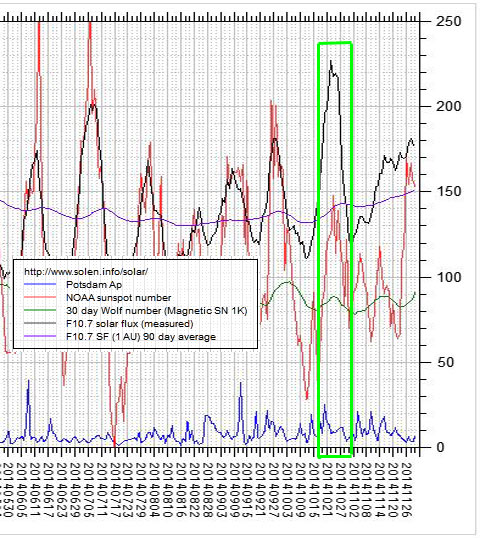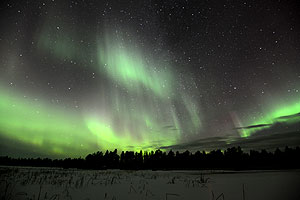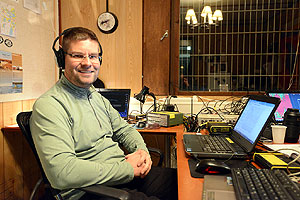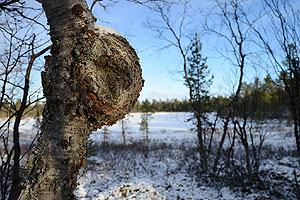|

High solar activity and clear
skies gave us impressive northern lights during
the first week, but AM propagation was worse than
I've ever endured in Lapland. Thankfully conditions
improved during the second week, when we hauled
in a bunch of new North American stations. Once
again we also attracted publicity for the hobby.
For the first time DXing was featured prominently
in the local Sami language broadcast media.
Just
as AIH29 a year earlier,
DXpedition AIH39 was a result of careful planning
to accommodate the schedules of all participants.
Everyone's arrival and departure dates happened
to be different.
Lauri
Niemi and Markku Jussila formed DXpedition AIH38,
and Lauri left on the day when I arrived. Markku
was supposed to continue with me for another week,
but left a few days early due to lousy propagation
conditions.
Jim arrived
on October 24 and was able to enjoy gradually improving
propagation until the end, November 1. However,
I had to leave two days earlier than originally
planned due to a reporting assignment in the Antarctic.
Here's a breakdown of the days each of us spent
up in Aihkiniemi:
• Markku Jussila: October
18–22, 2014
• Mika
Mäkeläinen: October 18–30, 2014
• Jim
Solatie: October 24 – November 1, 2014

Interspecies curiosity in the Arctic forest |
I left
Helsinki on Friday evening, October 17th, on an
overnight train that got delayed by an hour already
in Pasila, where cars were loaded. Some malfunction
I heard. I never sleep too well in a moving train,
but on Saturday morning I was rested enough to continue
driving, and happy to see that the train had caught
up on the schedule, as we arrived in Rovaniemi on
the Arctic Circle on time.
In only
20 minutes after arrival I was already driving north
towards Sodankylä and Ivalo for groceries shopping
(as were a large number of Russians from across
the border), and I got a full tank as well as the
last snack a bit later in Inari.
Driving conditions were decent,
the temperature was hovering around freezing point,
and there was a light sprinkling of snow covering
the ground, just enough to turn the brownish landscape
into pale white. Reindeer were of course visible,
but on the last leg from Kaamanen to Aihkiniemi
I was lucky to see also a fox on the roadside.
Fellow DXer Markku Jussila had
already spent a week in Aihkiniemi and was waiting
for me to join for his second week up there. Earlier
on Saturday, Lauri Niemi flew south from Ivalo,
after spending a week DXing. Propagation conditions
had not been optimal, but there was always something
interesting from some direction.
I arrived in Aihkiniemi at 14:30
local time I and finally got my two Perseus receiver
sets operational around 17:50 local time (1450 UTC).
The long delay didn't really matter, as conditions
to Asia were lousy, and there was nothing to listen
to anyway.

The Aihkiniemi cabin in October 2014 |
Personally, I have never begun
a DXpedition as unprepared as this time. Partly
it was a result of a decision taken by the Finnish
DX Association last winter. The FDXA changed rules
on counting station points, essentially inflating
the value of traditional personal verifications.
According to the new rule, collective
reception reports resulting in collective QSLs (for
instance by a party of two or three who happen to
be on the same DXpedition and more or less contribute
to a single collective reception report, resulting
in one shared QSL) are counted as if they were personal
achievements. So, everyone somehow involved can
count any "shared" QSL as their own personal
achievement and "point" while minimizing
individual effort to obtain it.
The change is a major deviation
from any international practice in collecting and
counting verifications. I lost all motivation to
take part in FDXA-run QSL competitions and rankings,
and felt this might be a good time to take a bit
of a break from the entire hobby as well.

Mika Mäkeläinen DXing |
Also, a bit earlier I discovered
a new medium to match the motivation that initially
made me a DXer –
namely, to find out what's happening around the
world. Back in my youth, shortwave radio was the
one and only means for it, but now, of course, everything
is online, and of all the tools available, I have
found Twitter to be the most satisfying one both
professionally and personally. You can follow me
at https://twitter.com/Mikareport.
Beware, Twitter is as time-consuming, addictive
and rewarding as shortwave radio used to be in its
golden days.
Partly my unpreparedness was
due to other factors as well. We built a house this
year, so I've been preoccupied with the construction
project. Work –
foreign news reporting –
has been extremely busy ever since Russia invaded
Crimea. And on top of it all, right after AIH39
DXpedition, I headed for a reporting assignment
to the Antarctic, which required a lot of preparation
and was also the cause for the delay in getting
this report published.

Aurora borealis with our cabin on the right,
shot from the frozen lake that is part of our
lot. |
So, when kicking off AIH39, I
was looking forward to a relaxing break from the
usual obligations without
much of a zeal to collect terabytes full of new
stations. And I got what I wanted. The best reward
from the first week were the numerous northern lights
(aurora borealis), visible on most nights
as the skies were exceptionally clear for this time
of the year. I spent countless hours outside and
shot better aurora photos than I've ever gotten
before, plus a couple of lucky shots of shooting
stars.
As for the increasingly popular
sideline activity of gourmet cooking, I still haven't
found anything better –
and easier –
than Kitchen Joy Thai cubes. Markku brought loads
of goodies from his store, and Jim preferred the
more traditionally Finnish meat pastries.
Solar activity decreased during
the second week, so we began hearing a bit more
trans-Atlantic signals and also some stations from
the Far East, so eventually the expedition turned
out to be a moderately good one also in terms of
DXing accomplishments.
Snow had arrived a bit earlier than usually, but
it mostly melted away during the second week. Temperatures
varied from around -15 degrees Celsius (5 Fahrenheit)
to above freezing. It rained only on a few days,
so setting up, fixing and checking antennas was
a walk in a park.

Above you can see
our antennas and bearings, which differed only slightly
from the previous season. Each of the antennas was
about 1,000 meters long. The 210-degree wire was
temporary and will not be available later in the
season. As receivers we have continued to rely on
Perseus.
Below is a graph
displaying solar terrestrial activity during a 5-month
period, with AIH39 dates highlighted in green. Thanks
to Jan Alvestad for the data:

There
were other more or less parallel DXpeditions in
Scandinavia at the same time. For comparing experiences
and results, you may want to take a peek at these:
- Parkalompolo (PAX106)
in Sweden
- Lemmenjoki (LEM345
and LEM346)
in Finland
- Kongsfjord (KONG24), in Norway, actually just
concluded, but still worth visiting their blog
as well as Bjarne Mjelde's personal DX blog
Time to dive into the details of our daily adventures
on the dial. Some day in the distant future there
will also be a comprehensive log, but it will be
published only after the Perseus files have been
reviewed.
Saturday,
October 18, 2014
When I finally got my stuff in
order, I made a few top-of-the hour recordings using
the 80-degree and 160-degree antennas, but didn't
notice much of interest. For a couple of hours there
was a Greek pirate –
presumably –
playing non-stop Greek music on 1566 kHz, any ideas
of the identity? Radio Asteras ("Star")
is listed
on 1566 kHz, but the linked web
feed doesn't match what I heard. Moreover, the
feed actually seems to be just a short 2-minute
recording, and not a live feed. Another listing
mentions also Radio Apithanos here. One more listing
contains only Asteras. I also know that Finnish
DXer Harri Kujala has heard Radio Asteras on the
X-band many years ago, indicating that the station
would be active (also) on 1566 kHz.

Aurora borealis lighting up the western sky |
On Saturday evening, when I began
monitoring the AM band, I didn't find anything new.
On 1601.84 kHz an unidentified station from the
south played non-stop pop music, any ideas of this
offset? At 1602 kHz sharp there was a local Sudanese
station from Kadogli, identified with local programming
in Arabic. A very nice catch, but a station which
I had picked up already before here in Aihkiniemi.
I began recording the eastern front from 1500 UTC
onwards, but mostly just using the 160-degree wire.
Saturday is easily summarized –
no sign of any Saturday night fever on the dial,
but an impressive display of aurora borealis
on the skies above.
Sunday, October 19, 2014
Overnight, there were hardly
any trans-Atlantic signals. A handful of the most
common North American stations were heard around
0345-0500 UTC, after which daytime was dead quiet
to all directions. We seized the chance and set
up a 1-kilometer-long antenna wire pointing at about
210 degrees, with Gibraltar, Mediterranean Spain
and Nigeria in mind. In the morning hours I focused
on European stations and identified "I am Radio"
on 1350 kHz, best around 0400 UTC, which must be
the fairly new Italian station listed as "AM
Radio".
|

Otsamo fell near Inari can be seen from highway
4.
|
In the early evening, Westsound,
a low-power Finnish shortwave station, emerged on
3959.93 kHz around 1500 UTC. Multilingual station
identifications were given at the top of the hour,
neatly for instance at 1800 UTC. On the AM band
I launched my recordings at 1428 UTC hoping in vain
for some new Iranian stations, which was the eastern
edge of today's Asian propagation.
The morning was cold, around
-15 degrees Celsius, but daytime high was close
to freezing point. Some aurora borealis was visible
through the cloud cover in the evening.
Overnight totally, utterly
dead to all directions. And the sky remained cloudy,
so no aurora photography either.
Monday, October 20, 2014
The only sign of trans-Atlantic
life in the morning was a brief appearance of some
of the most common Brazilian stations around 0500
UTC. However, for the second year in a row, the
210-degree wire proved to be a monster trap. I caught
three new Spanish stations (Hit FM Catalunya 828
kHz, COPE León on 1215 kHz, and SER Radio
Alcoy 1485 kHz). I have picked up Alcoy before,
but lost the recording, so this second chance was
a very welcome one. Spanish stations dived just
before the 0525 UTC RNE break.

Markku Jussila wondering about the surprising
GPS reading. This is where the 210-degree wire
ended. |
Daytime was dead on the dial,
and the first signals from the east emerged very
late, around 1430 UTC. Even then, propagation was
really poor, with mostly Middle Eastern powerhouses
filling the AM band. No more aurora photos, as last
night was cloudy, and overcast skies seem to continue
through tonight as well.
A local DXer, Kristian Waltari,
paid a brief visit to the cabin in the afternoon,
to get to know the place. Maybe we'll see him some
day taking advantage of the superb array of 13–14
Beverage antennas.
Tuesday, October 21, 2014
In the morning some Brazilian
and Argentinian stations were heard around 0200-0520
UTC, when signals rapidly vanished, leaving only
the local pest Murmansk (657 kHz) on the AM band.
I nailed Radio Imagen, Castelar, on 1710 kHz, and
there should be at least a couple of other new catches
once I get to review all frequencies.
|

Radio Imagen chief engineer Carlos Alberto
Viñas showing QSL certificates prepared
for Jim and Mika. Behind, Vilma Vega de Pavón,
wife of station manager Gerardo Pavón.
|
Incidentally, a month later when
I briefly visited Buenos Aires during my return
from the Antarctic, I called Radio Imagen, visited
the station, and got a very warm welcome with a
long on-air interview. Made me wish I had studied
more Spanish. Later chief engineer Carlos Alberto
Viñas showed me around the suburbs of Buenos
Aires and helped me get some filming done in Luján,
after I had recovered my camera tripod, lost by
Aerolíneas Argentinas on the way from Ushuaia.
OK, back to AIH39. The morning
opening closed too early for any Spanish treasures.
During the day there was again nothing to listen
to, so we took advantage of a crisp and sunny day,
checking several antennas and enjoying the outdoors.
In the evening, the first Asian
signals were audible around 1330 UTC, an hour earlier
than yesterday, but still much later than would
be typical for this time of the year. Initially
the 80-degree antenna was most useful, offering
some of the most common Chinese stations, but by
1445 UTC there wasn't much action beyond the 100-degree
wire enhancing signals from India and Thailand.
Then, by 1530 UTC, only the 160-degree antenna was
useful, as the AM band was dominated by Iranian
stations and the usual Middle East mishmash.
Overall, one more very disappointing
day without a single station from North America,
the Far East or Oceania. This is definitely not
what late October should be like.
Wednesday, October 22,
2014
A bunch of Brazilian stations
emerged as soon as the sun set down there on Tuesday
evening, and remained on the dial past 0000 UTC.
Despite strong European co-channel splatter, something
interesting might eventually be found in the recordings.
Soon after midnight UTC the signals however dipped,
and never resumed, not even during the regular daybreak
enhancement around 0400-0500 UTC. So once again
a lousy night, and nothing from more northern latitudes.

When you wish upon a star, makes no difference
who you are, anything your heart desires, will
come to you... |
Daytime was dead, as had become
the norm on this DXpedition, and the afternoon opening
to Asia began late. Chinese CNR on 1098 kHz was
the first station to emerge from the noise around
1315 UTC, and by 1400 UTC it was worth the trouble
to record the Asian mix on the 80-degree antenna,
for the first time offering some Philippine stations
as well.
Soon the typical Middle Eastern
hodgepodge became dominant. I guess I should be
very pleased having been able to identify two Iranian
stations that were new to me, namely Khorramabad
on 810 kHz and Kermanshah on 1377 kHz, both with
regional programming, but having to resort to figuring
out Farsi is just an indication of how profoundly
shitty the propagation conditions were.
I'm glad that the Internet connection
worked and that I was able to follow the world by
more technologically savvy means than age-old AM
radio. And yes, you should indeed be following @Mikareport
on Twitter ;)
|

Colorful aurora borealis above the Aihkiniemi
cabin
|
Markku got fed up with not hearing
a single North American station for days, packed
his stuff and began driving home already before
daybreak. So, now only I remained monitoring the
non-existent signals until Jim Solatie arrived on
Friday afternoon to share the misery.
Well, at least aurora has been
decent. I took more photos last night and sent a
few samples to my broadcasting company YLE. Tonight,
and for the first time already on Monday evening,
they published a few of my photos at the end of
the 7 pm national newscast, so at least something
useful has come out of this DXpedition.
In fact, the aurora photos have
been better than on any previous Aihkiniemi DXpedition
of mine. I've seen more impressive aurora years
ago in Lemmenjoki, but didn't have the equipment,
skills nor the motivation to document them back
then when I only focused on DXing. Now, priorities
have changed –
for the better, I'd like to think.
Thursday, October 23, 2014
Overnight was typically uneventful,
but in the morning there were stations to be hunted
from Argentina, as well as some Brazilians. South
American stations melted into the noise around 0550
UTC. Canary Islands transmitters dominated during
the first RNE regional break at 0525 UTC, which
unfortunately is a bit too late for optimal reception
– the Spanish
stations are on the verge of vanishing at this hour,
and reception is best about 20-30 minutes earlier.

A red squirrel looking
for food |
In the evening, I began recording
Asian signals just before 1400 UTC. Conditions were
not quite as dismal as on previous days, after all,
there were some Philippine stations in the mix,
and even ABC popped up on 1152 kHz at 1547 UTC.
Still, it is unlikely that I would find anything
new. Later in the evening, I once again recorded
Nigerian Radio Jigawa on 1026 kHz before it closed
down with the national anthem at 2311 UTC.
The weather was very windy, but
sunny, so I spent a couple of hours out in the forest
checking our antennas.
Friday, October 24, 2014
The morning enhancement, peaking
around 0500-0600 UTC, brought signals from more
northern latitudes than before. The usual suspects
from Argentina and Brazil remained, though weaker
than on the previous couple of days, but there were
also stations from Venezuela, Puerto Rico and East
Coast North America. With some luck, there could
be some pleasant surprises from the Andes buried
in the files. In the morning signals faded out at
0630 UTC, although some East Coast U.S. stations
reappeared after 0700 UTC. They were all too weak
to find anything of interest, but still it was a
positive development.
|

Jim Solatie arrived just in time for the improving
propagation.
|
I spent most of the daylight
hours driving, as I picked up Jim from the Ivalo
Airport. After some shopping we came to Aihkiniemi
just in time for the Asia opening. Iranian stations
and some Chinese stations from Xinjiang were the
first to stand out around 1320 UTC. Again the top
of the hour at 1400 UTC seemed worth recording,
but reviewing those recordings hasn't yielded anything
worth mentioning.
Saturday, October 25, 2014
Once again a lousy night with
a brief peak of "La Plata" (= Argentina,
Uruguay and some Brazil) stations before daybreak.
Identified stations included LRA6 Radio Nacional,
Mendoza, on 960 kHz, and CW41 Radio 41, San José,
on 1360 kHz. Just a handful of North American stations
were barely audible after 0600 UTC, which I guess
should count as a meager improvement.
There was nothing from anywhere
during the day, but the afternoon opening to Asia
began already at 1220 UTC (with the AM band worth
recording after 1250 UTC), much earlier than on
previous days. Some Thai stations were heard on
interesting frequencies at 1300 UTC, but –
at least so far –
no new station identifications were caught. In the
evening we hunted, in vain, for new catches from
Africa. Ethiopian Radio Wegahta, Mekelle, was once
again tentatively heard on 918 kHz, but I've never
been lucky to get an ID from this station.

Short days and long shadows |
During the day we spent hours
in the forest reconstructing the 10-degree antenna,
meant for Hawaii and Alaska. The first 700 meters
of the antenna had been broken and taken down by
earlier expeditionists, and had to be replaced by
us. Navigation was a bit challenging, and we couldn't
afford any deviation from the correct bearing, because
the wire needed to be connected to the last 300
meters still remaining. Eventually the work was
concluded successfully, and once again Aihkiniemi
had a total of 14 fully-functioning Beverage antennas
aimed at nearly all possible directions. Now all
we needed was for the sun to calm down and let the
ionosphere do its magic.
Sunday, October 26, 2014
One more night with a very familiar
pattern: very weak La Plata stations overnight,
and somewhat improved signals around 0500-0600 UTC.
Identified stations included CW35 Radio Paysandú
on 1240 kHz and ZYI827 Radio Papacaça, Bom
Conselho PE on 1470 kHz.
Again very few North American
stations were audible in the morning hours, with
KCKK Littleton CO on 1510 kHz being the only one
with an enjoyable signal level. The AM band was
still quite disturbed, and there was no hope of
getting any stations from Oceania during the day.
|

Lake Inari was freezing –
and you could hear it, ice cracking and popping.
|
I began recording Asian stations
at 1227 UTC. Initially there were a lot of Chinese
signals, but after 1400 UTC the focus was lost,
and the AM band became a hopeless mix of signals
from Saudi Arabia to Taiwan. It should be mentioned
that today I heard, for the first time in eight
days, a few stations from Japan, which just underscores
how crappy the propagation had been until now. With
our massive array of antennas to the east, the Japanese
powerhouses should be heard on a daily basis. On
a positive note, Radio Free Korea on 1143 kHz was
a new catch to me. This is of course a very common
station if only there is a decent opening to the
Koreas.
Fortunately, the largest sunspot
in 24 years (AR 2192) hasn't unleashed anything
major towards us.
In the evening, North American
stations appeared around 2230 UTC, which was a major
improvement from earlier days. The identified stations
were just regular catches from the Great Lakes area,
but still.
Monday, October 27, 2014

A great tit (Parus major) |
Later on, there were some fairly
weak South American stations, but daybreak resulted
in a short North America opening, including some
Mexican stations around 0530 UTC, especially from
Monterrey. XEAW Monterrey NL 1280 kHz and XETKR
Monterrey NL on 1480 kHz were the best ones identified.
Among the best –
athough familiar –
US catches were KATE Albert Lea MN and KGRZ Missoula
MT, both on 1450 kHz.
Some weak North American stations
from the West were heard through the day, but signals
were quite noisy. Also some Alaskan and Hawaiian
stations were picked up, especially around 1200
UTC, which was a welcome change in the propagation
pattern. Later in the afternoon, the first Japanese
stations appeared at 1215 UTC and were heard for
hours. Unfortunately NHK2 no longer had a local
break at 1320 UTC, so finding any new ones was close
to impossible. Japanese stations eventually gave
way to Chinese stations, and a good opening to Taiwan
was noted as late as 1600 UTC, so overall this was
a very rewarding afternoon session.
|

A burl in a birch trunk near our cabin
|
After surviving last week, my
least productive DX week in Lapland ever, now it
was beginning to feel like propagation was headed
back to normal.
However, the weather took a turn
for the worse. The temperature had risen to above
freezing point, and it had been raining since Sunday,
melting nearly all the snow. Even the ice cover
on our nearby ponds began to look a bit treacherous.
Tuesday, October 28, 2014
North American signals emerged
around 2315 UTC and stayed relatively strong through
the night, so this was the first night that might
actually provide something interesting from higher
latitudes. North American stations continued all
the way to the afternoon, when finally at 1130 UTC
I pulled the plug and opted to follow Asian stations
instead.

Camera crew from YLE filming
in Aihkiniemi. |
Conditions centered on the Midwest,
and fortunately all the graveyard frequencies had
readable signals, so our files are bound to contain
some goodies. From the east a station worth mentioning
is CHRF Montréal QC on 980 kHz, which only
began broadcasting on Monday evening. "Radio
Fierté" was quite surprised to hear
that their signal had reached Finland. The advertised
email for CHRF doesn't work, but you can find one
of their on-air talents, Marino Gagnon, on Twitter
@MarinoOnAir, which turned out to be the quickest
way to get in touch with the station. With a licensed
nighttime power of 10 kW, CHRF will become a regular
catch here.
Alaska and Hawaii were once again
present, and it was neat to be able to demonstrate
the sound quality of the "nearby" Alaskan
stations live to a visiting camera crew. Indeed,
also this year we got our 15 seconds of fame for
the hobby. This time DXing was featured on YLE's
Sami language service both on TV, Radio and on the
Internet. Disclosure: the same company I work for.
|

DXing featured in the Sami language with subtitles
in Finnish, on YLE
|
Reporter Erkki Gauriloff told
me that one of the reports would be broadcast in
the Skolt Sami language, which is spoken as native
tongue by only about 300 people! Most of the Skolt
Sami people live in this particular area, close
to the Russian border. I don't think that anything
about DXing has ever, anywhere, been published in
such a small language.
So, the Japanese stations appeared
even earlier than yesterday, but the opening wasn't
as sustainable. Fairly soon all frequencies were
taken over by Chinese and Taiwanese stations, and
South Asia as well as the Middle East tended to
dominate the dial by 1600 UTC. Philippine stations
were quite strong around 1430 UTC.
Aloha
and Mahalo to all! We got a nice opening to Hawaii.
After there was no longer any chance to hear new
Hawaiian stations on the AM dial, I entertained
myself by listening to KKNE Honolulu HI on 940 kHz,
broadcasting traditional Hawaiian music. Unfortunately
the KKNE web feed is not available – without
donation – outside Hawaii, but here's a good
substitute
station to get into the Hawaiian spirit. This
is the best imaginable antidepressant during the
polar winter.
Wednesday,
October 29, 2014
Quite a few US East Coast stations
were heard around 2300 UTC, but later during the
night conditions to North America dipped. In the
morning North American stations were again heard
at moderate strength, quite not on par with the
previous day, but still good enough to enable a
few new catches, especially on graveyard frequencies.
US stations continued through the day, although
at times the signal levels were low. Western stations
were audible past 1400 UTC.

Halo: two "sun dogs"
and a partial 22-degree halo |
The afternoon opening to Asia
was very peculiar, as the first Japanese stations
were heard from 1315 UTC, but nothing else from
the Far East was available for hours. Instead, loads
of Iranian stations appeared quite early. The strange
Asian mix didn't bring about any rarities, but at
the same time (after 1300 UTC) it was very enjoyable
to listen to Alaskan and Hawaiian stations at good
levels for a couple of hours. For example KCIK Kihei
on 740 kHz had a fairly strong and stable signal.
A new Hawaiian station is always a cause for celebration!
Thursday, October 30, 2014
I packed my stuff overnight,
and Jim drove me to the Ivalo airport in the morning.
The following comments on propagation conditions
are from Jim:
Thursday offered some decent
North American signals, the highlights being KWRT
Boonville, MO on 1370 kHz and KDCC Dodge City, KS
on 1550 kHz. In the evening some common daytimers
were observed between 2200-0000 UTC: WJML 1110,
KKOJ 1190, WWSM 1510 and WIZZ 1520.
Friday, October 31 & Saturday,
November 1, 2014
Both Friday and Saturday started
with a nice opening to Venezuela and Ecuador. The
signal from Radio Santiago, Guayaquil on 540 kHz
was enjoyable, and also some more common stations
from Ecuador were heard with strong signals, like
Radio Sucre on 700 kHz and Radio Cristal on 870
kHz. On Friday evening the daytime opening was somewhat
disappointing, even though KKOJ on 1190 kHz had
again a decent signal around 2330 UTC.
|

Sajos is a Sami
cultural and administrative center, located
in Inari. Sajos is also home to the Sami parliament
|
Once again Aihkiniemi
offered a great getaway, and this time even a useful
acclimatization before I headed to Antarctica. What
more could I wish. Well, come to think of it, for
starters I could take a one-year leave from my job
to be able to review most of the recordings made
up there.
You can read my travel blog from
the Antarctic here.
Sorry, but it's only available in Finnish. Google
translate just might be able to make some sense
of it. However, I promise to continue blogging in
English from my upcoming DXpeditions, whenever the
next one might be. And, did I already mention my
tweets?
Published
on December 6, 2014
  
|